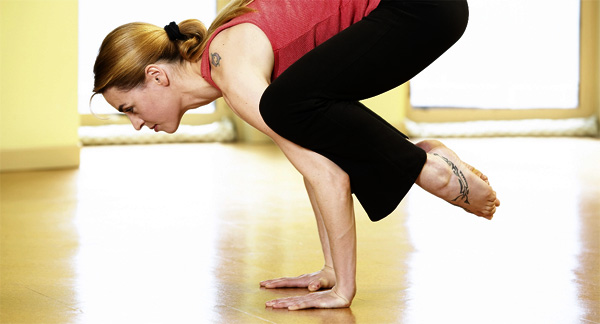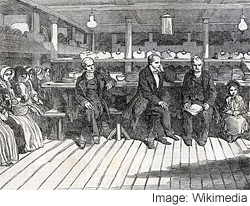READING
Text 1
Read the instructions for the yoga exercises and choose the correct answer for each item.

The cat pose
Start on your hands and knees. Your wrists should be directly under your shoulders and your knees directly under your hips. Keep your head at the level of your spine. Now breathe out slowly and round your back toward the ceiling. It should look like a cat stretching its back. Gently lower your head, breathe in and lower your back to the starting position. Repeat the sequence ten or twenty times.
Remember
If you have a neck injury, don’t lower your head. Keep it in a neutral position.
Benefits
This exercises warms the body and makes the spine flexible. It stretches the back and neck and gives the stomach and internal organs a gentle massage.
The chair pose
Start in a standing position, breathe in and slowly raise your arms over your head, palms facing inward. Breathe out and slowly bend your knees, as if you were going to sit on a chair. Keep your arms raised. Hold this position for 30 seconds. Slowly breathe in, straighten your knees and lower your arms.
Remember
Don't try this exercise if you have low blood pressure or if you have knee or hip pain as it could make the pain worse.
Benefits
The chair pose makes your legs stronger and stretches the shoulders and chest. It stimulates the stomach and internal organs as well as the heart.
The boat pose
Sit on the floor with your legs stretched out in front of you. Place your hands on the floor, behind your hips. Lean back slightly and raise your knees so that your feet are off the ground. Straighten your legs and raise your toes to the level of your eyes. Stretch out your arms in front of you, with your palms facing inward at the level of your knees. Hold the pose for 30 seconds.
Remember
You shouldn’t do this exercise if you have asthma, a headache or heart problems.
Benefits
This pose makes your abdomen and back stronger. It’s good for the digestion and it helps relieve stress.
Text 2
Read the Wikipedia article and choose the correct option for each item.
 Australian English
Australian English
Australian English is an important variety of English that is spoken in Australia. It is the first language of the majority of the population in this country.
Australian English began to change as soon as the new Colony of New South Wales was established in 1788. By 1820, Australian English was recognised to be different from British English.
The earliest form of Australian English was spoken by the children of the people who established the colony. The first generation of children born in the Colony of New South Wales created a new dialect, which later became the language of Australia.
Immigrants and convicts who established the colony spoke different dialects from different parts of Britain and Ireland, especially the south east of England. The children born in Australia were exposed to these different accents, which formed the basis of a distinct Australian dialect.
Records from the 19th century document the changes in the language spoken in Australia. In 1827 a Scottish naval doctor wrote a book called Two Years in New South Wales, where he describes the accent and the vocabulary of the people born in Australia. Later studies have shown that Australian English preserves some aspects of 19th-century cockney, the dialect spoken in London. Since then Australian English has continued to change, especially the vocabulary and pronunciation.
The main influence on Australian English came from British English, but in 1851 gold was discovered in New South Wales. Thousands of immigrants from all over the world arrived in Australia to look for gold. From then on, Australian English was also influenced by North American spelling and expressions. The arrival of military personnel in Australia during the Second World War and the popularity of American pop culture also had an effect. As a result, Australians use many British and American words interchangeably, such as trousers/pants or lift/elevator.
Some elements of Aboriginal languages have been adopted by Australian English, especially place names and words for animals and plants. For example, the name of the capital city, Canberra, means “meeting place”in the local Aboriginal language. Other words, such as “kangaroo”, “boomerang” and “wallaby” are now international.
Text 3
Read the trip review from a website and the questions that follow, and choose the correct answer.
julyacharles Sydney, Australia
***** Reviewed 11 February
LISTENING
There are three parts to this section of the test. In each section, read the questions then listen or watch and choose your answers.
Text 1
You are going to listen to four different speakers talking about the exploration of space. Listen to the audio and decide whether the following statements are true or false, according to what each speaker says. (In the official test you only hear the recording twice.)
Text 2
You are going to watch and listen to an instructor talking about good posture for people who work at a desk. Watch the video and choose the best option for each item, according to what the instructor says. (In the official test you only hear the recording twice.)
Note: The speaker talks about a work station. This is a desk and computer where an office worker works.
Choose the correct answer for each item.
(Original video source: Correct Ergonomic Workstation Set-up | Daily Rehab #23 | Feat. Tim Keeley | No.112 | Physio REHAB
https://www.youtube.com/watch?v=GYBClo_zbsg)
Text 3
You are going to listen to a dialogue between two people, Alexis and Brian, who meet at a bus stop. They are both travelling and camping. Listen to the audio and decide whether the following statements are true or false. (In the official test you only hear the recording twice.)
Choose the correct answer for each item.